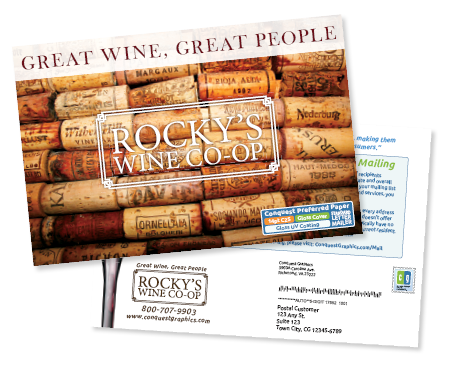
In the last decade, industrial businesses have taken great strides to create sustainable manufacturing practices. Commercial printing is leading the charge in many of those efforts that help preserve our environment.
Whether in advertisements or even on the packaging of the products we purchase everyday, the terms “eco-friendly” or “green” have become as pervasive as the efforts they represent. What does it mean to be a “green” printer and what steps are taken during the printing process to promote sustainability and cut down on waste?
When thinking of industries that are at the forefront of environmentally friendly practices, commercial printing may not be the first to come to mind but huge strides have been made to create a more sustainable printing process. Cutting down on waste not only helps the environment but it cuts down on costs for the printer and that savings is passed down to the customer.
Dramatic efforts are made to increase both energy efficiency and the amount of materials recycled. Commercial printers have done a great deal to make it known they intend to do what they can to preserve our environment.
Recycling, reducing and responsible paper sourcing
When printing comes up the first thing you may think about in regards to environmental impact would be the amount of paper that is used. While it is true that commercial printers use a lot of paper, steps like using paper made from recycled materials, and recycling scrap help cut down on overall waste.
Collection bins are placed throughout production areas where waste or misprinted paper can be gathered for recycling. Often print jobs are cut to size and when this occurs the trimmings are collected and placed in recycling bins as well. At our facilities here at Conquest Graphics we have recycled over a million pounds of paper this year, which goes to show just how much a responsible printer can do to help conserve resources.
Even the plates used on the printing presses, which are made from aluminum, can be collected and recycled.
Beyond the production side of printing, eco-friendly business practices contribute to the efforts being made by the industry. A completely digital prepress and design workflow used in conjunction with paperless communication methods also eliminate unnecessary paper and ink use in the printing process.
In addition to robust recycling efforts, sourcing paper from fast growing sustainably-managed pulpwood plantations further reduces a printer’s ecological impact. Use of water-based, low-ammonia emission aqueous coating on most printed products helps reduce fingerprints and marking, and is also much more environmentally-friendly than other coating methods.
Paper that is made from recycled material has also become an industry norm that carries forward the idea of environmentally responsible production.
Energy efficiency
Reducing energy consumption is a large task in the printing industry due to the machinery and warehouse space associated with the process as a whole.
Reducing energy consumption for any manufacturing facility is an important step towards sustainability especially for commercial printing. High capacity presses and post production machinery can be wasteful if energy consumption is not taken into account. Not to mention the cost of cooling and heating a large warehouse space.
Streamlining prepress operations reduces energy use, but advances in the printing presses themselves have contributed largely to cutting down on power consumption. First and foremost, a great deal of printing companies have improved their energy efficiency by retrofitting older buildings with a variety of upgrades that reduce their overall energy usage. Replacing older, high wattage lighting with cool-running and efficient fluorescent lighting as well as replacing aging and inefficient HVAC units with high SEER rated units are steps that make a huge impact on overall energy footprints.
By choosing production facilities that employ energy efficient construction methods and renewable materials such as brick, stone and concrete, conscientious printers are saving money and reducing their environmental impact.
One step that many in the printing industry have taken to maximize their energy efficiency and reduce operational costs is capturing the heat generated by machinery. This process consists of capturing the heat through tubing similar to the way a conventional heat pump and rerouting it throughout the building to reduce the use of HVAC systems during cold months.
Current printing press technology has dramatically improved energy efficiency and reduced the impact to the environment by cutting waste to a minimum. The implementation of H-UV presses has reduced the amount of energy used to cure the inks used in printing by utilizing ultraviolet light which cures inks instantly rather than having materials sent from the press to a secondary drying area. The speed and automated nature of these presses also offers the benefit of giving a production team quick proofs with minimal wasted paper.
Environmental issues continue to be a topic of heavy discussion. Fortunately as a consumer, you can be assured that the commercial printing industry is leading by example in its efforts to maximize its energy efficiency and reduction of waste.
As green technology advances and more energy efficient methods of producing marketing materials are created, the print industry will continue to follow the course it has been on. Leading the way towards environmentally friendly products and services while reducing the cost to our planet and consumers in the process, the print industry is making huge strides.
Learn More About Green Printing









